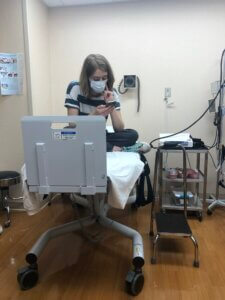What is the Tilt Table Test (TTT)?
The diagnostic test for POTS (postural orthostatic tachycardia syndrome) is the tilt table test (TTT). I know, that’s a lot of acronyms — welcome to the medical field. Essentially, the goal of this test is to measure how your body reacts to going from a lying down position to an upright position. Some conditions can emulate the symptoms of POTS, without the direct correlation to position. To get a clearer picture of what’s going on, the test has you lay on a table that then tips up (as if you were standing up) while monitoring all kinds of variables. In order to be qualified as POTS, a person’s heart rate has to go up by at least 30 beats per minute, and the accompanying symptoms of typical episodes must be present once in the upright position.
Why the Tilt Table Test?
In the early weeks of dealing with my newly escalated symptoms, I did a lot of research. Ill-advised, I am aware, but I was just so fascinated by the symptoms, the potential mechanisms behind them, and what others have experienced. There were a handful of things I considered plausible causes, but the main one that stuck out was POTS. I learned about the tilt table test, but I also learned that you can do the “poor man’s tilt table test” at home, where you lay down until you’re at a good resting heart rate, and then you stand up. With a pulse oximeter, you watch your heart rate, and see what happens. I couldn’t resist the temptation to give it a whirl, so I did (I have attached the actual video at the bottom of this post). My resting heart rate was 77, and after a few seconds upright, my high was 127. That is an increase of 50 bpm (and again, 30 bpm is the typical diagnostic threshold). After about a minute of heart rate fluctuations, I felt extremely lightheaded, shaky, and nauseous. This at-home test gave me another reason to further explore a POTS diagnosis, so when my cardiologist mentioned the tilt table test, I was on board.

Clarifying The Test
First, my lovely nurse took several minutes to explain exactly how the test was going to work. She was extremely knowledgeable about all aspects of the test, as well as the treatment of POTS. “I just love it when people are active in their healthcare. Keep the questions coming!” she said, with genuine excitement. I had many questions I had been wanting to ask, such as how salt/water intake impacts daily fluctuations from high/low blood pressure, how gaining weight might impact my symptoms, how a Fitbit might be of use in management, why the Isuprel was ordered for my TTT, and others. I also gave her a document that I had put together, outlining the overview of my health problems in a timeline, which she enthusiastically accepted and added to my file.
One thing she reiterated several times was that this testing was voluntary and if at any point I decided I was done, I could make that call. And furthermore, if I wanted to complete the test without the use of the medication to make the symptoms worse, that is my call as well. While it can often be helpful to have the symptoms artificially exaggerated to capture the data, I ultimately decided to pass. I knew that as soon as I would be boosted upright I would experience my symptoms with relative gusto. I knew my body, and today was an especially symptomatic day. Even just sitting, I was in “sinus tachycardia” (heart rate over 100) and minutes earlier when I had stood up to go use the restroom, I was at 120 bpm. My body had enough of its own chemical cocktail going on, I didn’t need additional help. She confirmed that forgoing the medication was a reasonable conclusion given the circumstances, and we got started.
The Test Itself
First, she set up the data-catching monitors. As I made myself flat on the table she set up a blood pressure cuff on my arm, a continuous EKG (with sticky patches on my chest), a pulse oximeter (clipped to my finger), and a beat-to-beat blood pressure finger cuff. She also situated several straps across my body to keep me from falling if I passed out. Once all the systems were up and running she marked the time, and then hit the button to cause the table to tilt up.
And I know, it’s kinda odd.
For the normal human being, it sounds quite silly. You lay down, and then a machine helps you stand up… what’s the point? But for the symptomatic POTS patient, it takes a lot of effort to stay coherent as your body fights gravity — and loses. To make things worse, by using the tilt table, we bypassed the mechanical assistance of the leg muscles contracting which naturally helps with blood return to the upper half of the body. Instead, it was a passive “standing up” and gravity got to have its way.
As I got boosted upright, I was amazed at the intense sound and feeling of blood rushing through my body. I could feel my heart beating in my throat and cheeks, and I suddenly wasn’t sure if I was going to throw up. Within 10 seconds everything got dim, I had ringing in my ears, and my feet felt like they weighed a thousand pounds. Oh, how I wished I could march in place, or walk around, or sit back down! Instead, I stayed in place… and then my vision blacked out and I went unresponsive.
Another thing about me, is that I deal with a variety of mental health conditions, including anxiety. Sometimes it can be hard to sort my symptoms into the different boxes, especially after learning that a lot of what I had previously thought of as mental health-induced problems were actually medical in nature. That said, the intensity of the symptoms and the loss of consciousness resulted in a wave of significant anxiety. I tensed up, and had a panic attack as I regained my wits and the nurse quickly lowered the table back to horizontal. After silently thanking the straps for doing their job and a few minutes of regaining my composure, I took a few deep breaths, gave a half-hearted laugh, and looked over to see my nurse in relative uncertainty. She offered for us to be finished, but I insisted I wanted to try again. She made a call to the overseeing neurologist and he gave the ‘OK’ to try again. I was determined to have a legit test that could tell me if I did have POTS.
Take two! She let me rest for a bit, and then we tried again. This time my symptoms were still present, but less immediately overwhelming. I had several waves of the classic symptoms, with a continuous thumping/pounding/flopping in my chest that reminded me of a freshly caught fish that is attempting to escape the cooler. Within a few minutes, I noticed the tops of my feet had a prickly, tingly pain. Several minutes later the pain had crept up to my ankles, and a few minutes after that, the pain was halfway up my calves. This also happens to me when I shower (because showering = standing in one place) — and for those who might experience it too, the antidote for me is compression socks.
It was odd, because at home when I almost black out I usually sit down. So to simply push through the feelings and sensations was pretty wild. In the end, I triumphantly completed all 30 minutes of the second test without losing consciousness and was hopeful they were able to capture the necessary data.
After completing the TTT and additional autonomic testing, I went down to the medical records office and requested the information from the tests. I wanted to be able to see the nuances of the numbers and was completely intrigued by the process as a whole. After receiving my packet, I found that my baseline pulse was 99, and my blood pressure was 127/77. During the test, my pulse ranged from 102-148, and my blood pressure ranged from 113/69 to 146/93 with fluctuations within those ranges for the entirety of the test. Each time I noted significant symptoms, there appeared to be a direct correlation to changes in heart rate and blood pressure, which was pretty neat to see in the data.
Findings
As found on my medical records: “Interpretation of the tilt table testing: Abnormal study, postural tachycardia with replication of typical symptoms in association with severe anxiety.”
After discussion with my cardiologist, I will be utilizing lifestyle management to deal with my symptoms (compression garments, water, salt, electrolytes, slow posture changes, incremental exercise, etc.) and was given the name of a POTS specialist in Milwaukee that I can consider going to. Ideally, I will be keeping a log of the things I have tried and how they have helped/hurt, and bring that information to the specialist once I go.
Final Thoughts
The tilt table test for me was a non-invasive test that offered me the chance to dig deeper into my symptoms and get a better understanding of how position is related to what I experience. I bounced back to baseline functioning within a few days (with a few naps throughout!). Even though the test had its uncomfortable moments, it was worth the effort to know that there is something more than just anxiety at play.
My “Poor Man’s Tilt Table Test”
Here is where I tried a similar test at home.
Have you had a tilt table test? How did your experience differ? Please comment below!
Getty image by Westend61

